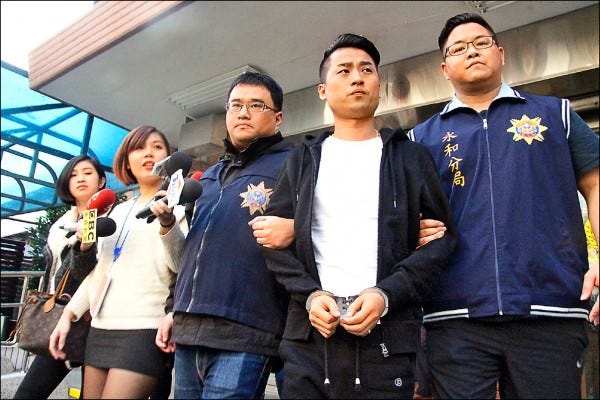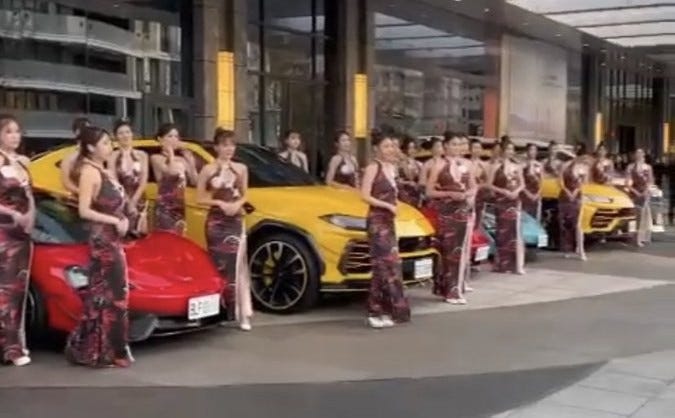China Eyes Taiwan’s Gangsters as Possible Invasion Tool
Taiwan’s 70,000 police face 200,000–300,000 gang members?
By: Jens Kastner
While the Chinese military has since 2022 frequently simulated blockades, joint precision strikes and cyber warfare against Taiwan, the mainland government has also been preparing recruitment of Taiwan’s hundreds of thousands of gangsters by compiling a "Taiwan Armed Gang Distribution Map", according to a series of investigative reports produced by Taiwan’s Chinese-language Mirror Weekly and first reported on in English by the China in Arms substack blog.
Mirror Weekly claims that the existence of the 30,000-word intelligence dossier has been confirmed by a handful of unnamed Taiwanese security sources. It uses concentric circles to mark the respective strongholds of the gangs of each county and city on the map of Taiwan, including detailed information such as the mobilization radius, the number of guns, and the phone number of the gang owner. It even uses an A–C grading system to mark each gang’s willingness to cooperate with the Chinese Communist Party (CCP). Level A is rated as “contact, positive response,” level B is “attitude wavering, continuous penetration,” and level C is “position is unclear and needs to be tested again.” In addition, the “Taiwan Armed Gang Distribution Map” shows that temples all over Taiwan function as secret meeting places, material warehouses, and pipelines to conceal the entry of dangerous people from China or to launder money.
The enormous number of gang members in Taiwan is a phenomenon that stretches back to the 1950s following the retreat of Generalissimo Chiang Kai-shek and his Kuomintang troops from the mainland. The Four Seas Gang was founded in 1954 and is the second largest in Taiwan, with 46 branches and over 700 known members. The Bamboo Union, perhaps the most notorious, was formed by children of Kuomintang soldiers who wanted to consolidate power against indigenous Taiwanese. The Bamboo Union, according to several histories, is known to have had close ties with the Kuomintang government and Chiang’s own family. Between 1960 and 1984, Bamboo Union members held up to 19 top government positions, including posts in the National Security Bureau, all branches of the armed forces, and the Ministry of Justice Investigation Bureau.
As in Japan with the Yakuza, the funerals of crime bosses have become a cultural phenomenon, often covered in national media. As many as 10,000 gangsters from as far away as Japan took part along with friends and family in a funeral service for the nation's most renowned underworld crime Hsu Hai-ching (許海清) in Taipei in 2005 as police videotaped the funeral procession to keep tabs on criminals.
The Mirror Weekly report mentions a few examples of gangs, such as a major northern one that funds itself through construction companies, earthmoving projects, illegal casinos and hostess clubs. Another in Taipei’s Sanchong area has set up telecom “fraud parks” in Cambodia, Myanmar, and elsewhere in Southeast Asia. A central Taiwan gang specializes in producing drug precursors in China, shipping them via third-party countries to Japan.
“China understands the financial structure of these gangs and can put pressure on the senior level of the gangsters by grasping the gangs’ overseas capital flow, supply chains, and dependence channels,” explained Mr. A, a management officer, as cited by the Mirror Weekly.
“In addition, some Taiwanese gangsters have already been operating in various industries in China, such as construction contracting, electronic parts trade and gray logistics, and these undertakings mostly rely on the shelter of Chinese local officials, so it’s easy for Beijing to make these gangsters help subvert Taiwan or fight on China’s side during an invasion.”
Mr. C, another unnamed cited security expert, pointed out that the current police force in Taiwan is about 70,000, which is far less than the 200,000 to 300,000 gang members the “Taiwan Armed Gang Distribution Map” claims to exist. The map not only marks the gangs’ locations but also the exact locations of nearby police stations and other public security units.
“Coupled with the gap in weapons and firepower between the two sides, the police are obviously at a disadvantage. If China really succeeds in tying Taiwanese gangsters, their destructive actions will cause devastating blows to Taiwan,” Mr. C told the Mirror Weekly.
Although it has long been known that the gangs have a large number of personnel and weapons and have been listed by China as the primary target of actively attracting and infiltrating to become a weapon to invade Taiwan during the war, the uncovering of the “Taiwan Armed Gang Distribution Map” suggests that the Chinese side has been doubling down on the recruitment effort. It follows Taiwan’s National Security Bureau in January specifically warning that China will collude with gangsters in Taiwan to develop armed forces and absorb retired Taiwanese soldiers to set up "sniper teams" to attack military facilities.
In March, Taiwan’s President Lai Qing-te predicted that China will absorb gangsters to carry out subversive and destructive activities in Taiwan. The Bureau of Investigation has been carrying out a gang-target “financial anti-crime” operation since last year.
Speaking to Asia Sentinel, Wendell Minnick, a veteran Taipei-based military analyst and the editor of China in Arms, said that the gangs have a mishmash of weapons at hand, including military-grade and police-grade ones.
“An Israeli 9mm Jericho semi-automatic pistol that was involved in an assassination attempt a few years back was actually stolen from the Vietnamese police,” Minnick said. “They get these weapons via cargo vessels who sneak a few in at any given time."


